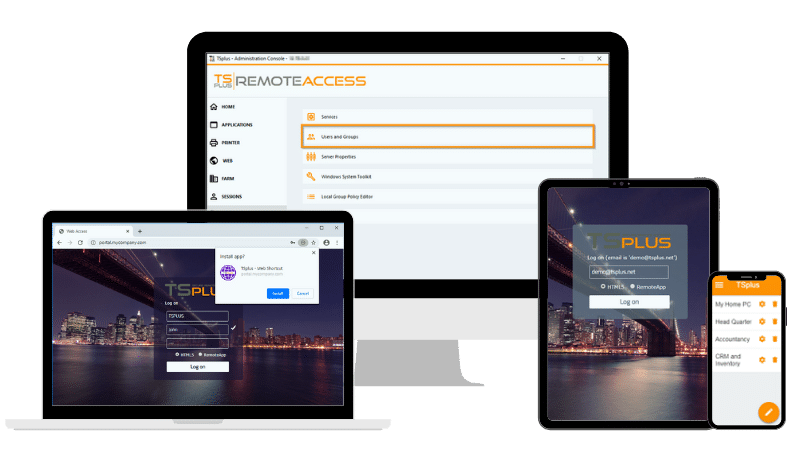)
)
Why Remote Access for iPhone, iPad, smartphones and tablets?
Modern work is mobile. As a freelancer, IT administrator or remote employee, having access to your work PC from your iPhone or iPad is a major productivity booster. But some remote access tools come with hurdles: complex configurations, apps you are loath to install, or user interfaces which refuse to adapt well to small touchscreens. All the opposite, TSplus offers a simple, seamless, HTML5-based Remote Desktop Protocol (RDP) experience directly from your iOS browser.
What is HTML5 Remote Access?
HTML5 remote access is a modern, browser-based solution that allows users to launch and control a full Windows desktop session from virtually any device, including iPhones and iPads, using only a web browser. It replaces traditional remote desktop software with a lightweight, flexible interface which requires no installation or configuration on the client device.
Here is why it is increasingly preferred:
-
No apps or plugins required
Everything runs in the browser, no need to install or update separate remote desktop clients. -
Cross-browser compatibility
Supports all major browsers such as Safari, Chrome, Firefox and Edge, making it truly platform-independent. -
Touchscreen and display optimization
Interfaces are designed to scale with screen size, ensuring that controls and visuals remain usable on both smartphones and tablets. -
Global access from any internet-connected location
Whether you're working from home, travelling or on-site at a client’s office, HTML5 access enables secure and instant connectivity to your Windows environment.
This approach removes traditional remote access barriers like software restrictions, installation permissions, and device compatibility. That makes HTML5-based RDP an ideal solution for mobile users, especially those on iOS devices who value speed, simplicity, and security.
How do RDP and HTML5 Bridge the Gap Between Windows and iPhones and iPads?
Remote Desktop Protocol (RDP) is a Microsoft-developed protocol that enables a user to connect to and control a remote Windows computer over a network. On iPhones and iPads, there are two primary ways to use RDP:
-
Via Native RDP Apps
Apple users can download RDP client apps, such as Microsoft Remote Desktop from the App Store. These apps establish a connection using the RDP protocol by entering the IP address or hostname of the remote Windows machine, along with login credentials. Once connected, the iOS device displays the remote desktop, allowing the user to interact with the remote PC using touch gestures or on-screen keyboards. -
Via HTML5-Based RDP Clients
Alternatively, users can connect through a web-based RDP interface provided by an HTML5-compatible remote access server. In this setup, the remote desktop session is rendered within a browser like Safari or Chrome, eliminating the need for any app. This method uses the RDP protocol on the backend but transmits the session through a secure, interactive web layer that supports touch input and mobile display formats.
Both approaches enable full access to Windows desktops and applications from iOS devices. The key differences lie in user experience, installation requirements and compatibility with enterprise security policies.
What are the Key Benefits of HTML5 over RDP for iOS?
Using HTML5-based Remote Desktop Protocol (RDP) access on iOS devices provides a range of practical advantages for mobile users needing secure, real-time access to Windows systems:
- No App Installation Required
- Cross-Platform Compatibility
- Touchscreen Optimization
- Low Bandwidth Requirements
- Always Up to Date
No App Installation Required
Since HTML5 runs in the browser, there is no more need to download or manage a separate application. This is ideal for shared, restricted or corporate-managed iPhones and iPads.
Cross-Platform Compatibility
HTML5 works seamlessly across major browsers like Safari and Chrome, allowing users to connect from virtually any device without dependency on a particular OS or platform.
Touchscreen Optimization
HTML5 RDP interfaces are often responsive and designed to adapt to small screens, making navigation, input and gestures easier to use on iPhones and iPads compared to legacy remote tools.
Low Bandwidth Requirements
Compared to full app-based virtual desktop infrastructure (VDI) solutions, HTML5 RDP sessions often consume less bandwidth, making them suitable for use on mobile data or in areas with weaker connections.
Always Up to Date
With browser-based tools, users benefit from the latest security and feature updates without having to manually update a remote access app.
These benefits make HTML5 RDP an ideal method for users who require lightweight, responsive and accessible remote desktop sessions directly from their iOS devices.
RDP has been a critical technology in enterprise computing for over two decades. TSplus builds on that reliability with a mobile-friendly front-end.
What Security Features does HTML5 Hold for Mobile Remote Access?
Accessing a remote desktop from an iPhone or iPad introduces a unique set of security considerations. HTML5-based RDP clients offer several security benefits designed to protect both the user and the host system:
- End-to-End Encryption
- Firewall Compatibility
- Strong Authentication
- No Local Data Storage
- Session Timeouts and User Controls
End-to-End Encryption
Most HTML5 remote access implementations use HTTPS ( SSL/TLS ) encryption to secure data transmitted between the mobile browser and the host system, preventing eavesdropping or interception over public networks.
Firewall Compatibility
Web-based RDP systems often require only a single open port (e.g., 443 for HTTPS), making them easier to secure and monitor compared to legacy VPNs or multi-port configurations.
Strong Authentication
Remote access should require secure login credentials. Ideally combine them with multi-factor authentication (MFA) to prevent unauthorized access, even in the event of passwords being compromised.
No Local Data Storage
When using HTML5, all activity remains within the browser session, meaning no files or session data are stored on the local device, unless explicitly downloaded. This reduces the risk of data leakage if a mobile device is lost or stolen.
Session Timeouts and User Controls
Browser sessions can be configured to expire automatically after a period of inactivity, minimizing the risk of unauthorized access if a device is left unattended.
Integration with Authentication Systems
Many HTML5-based platforms support integration with standard identity providers, including Active Directory or SSO tools, allowing enterprises to enforce existing security policies even on mobile access points.
Integration with Authentication Systems
Many HTML5-based platforms support integration with standard identity providers, including Active Directory or SSO tools, allowing enterprises to enforce existing security policies even on mobile access points.
By following these practices, organizations and individuals can leverage the flexibility of HTML5 and RDP on iPhones and iPads without compromising security.
Why Not Use the Microsoft RDP App for iOS Instead?
Microsoft does offer a free RDP app on the Apple App Store which comes with several drawbacks:
Requires App Installation
Not every user wants to install third-party apps, especially on corporate or shared devices.
Complex Setup
Users often need to configure IP addresses, user permissions and security rules manually. Proper RDS deployment generally requires Active Directory integration and port forwarding.
Poor User Experience on Mobile
Not all app interfaces are optimized for small screens or touch gestures, making basic interactions like right-clicking or scrolling difficult.
Remote Authorization Conflicts
Often, the host machine will request confirmation before allowing the connection. If not physically near that PC, you will be stuck.
Security Concerns
Some users hesitate to grant full desktop access via external apps they did not configure themselves or fully trust.
By contrast, TSplus eliminates these pain points through a secure, browser-based connection with minimal setup.
TSplus Remote Access - How It Works on Apple (or Other Smartphones)
TSplus makes remote desktop access from iPhones and iPads as straightforward as opening a web page. Designed with simplicity and speed in mind, the solution requires no mobile installation and minimal server-side setup.
Here is how the process typically works:
- Install TSplus on your Windows machine (pro PC or server). The installation includes everything needed: the web server, HTML5 RDP gateway and security components.
- Launch the built-in web portal which serves as your access point.
- From your iPhone or iPad, open Safari, Chrome or your preferred browser.
- Navigate to the provided web address, usually in the form of https://yourcompany.tsplus.net.
- Log into the portal using your credentials and begin your session.
Access Windows desktops or applications in real time:
The remote session appears inside your browser window, fully interactive and optimized for touch gestures. Whether you aim to check a report in Excel, access Outlook or run internal applications, everything behaves as though you were sitting in front of your Windows machine.
This browser-based method is especially effective for mobile users needing quick access without having to manage software issues.
Who Uses TSplus on iOS?
TSplus Remote Access is used by a wide variety of professionals and industries requiring reliable desktop access from Apple devices; especially in environments where traditional VPNs or RDP apps fall short.
Common use cases include:
- Remote employees and digital nomads securely access their work PCs from anywhere, be it an airport, hotel or home office.
- IT support staff access internal tools, diagnostics or server infrastructure directly from their phones or tablets when away from their desks.
- Small business owners manage operations on the go without deploying full IT stacks or infrastructure.
- Field technicians or consultants connect to a back-office application while on a client site.
- Corporate teams obtain centralized access for dozens or hundreds of mobile users without managing software on every device.
The flexibility of a browser-based RDP session means that users across roles and technical expertise can all benefit, from solo entrepreneurs to enterprise IT departments.
How to Get Started in Minutes
One of the standout features of TSplus is its incredibly fast deployment process. It is ideal for businesses needing to scale remote access quickly or individuals preferring minimal configuration.
To start using TSplus with your iPhone or iPad:
- Download the TSplus Remote Access installer from the official website.
- Run the installation on your Windows PC or server. The installer auto-configures most settings including firewall rules and SSL certificates.
- Set up user access, either using local Windows accounts or integrating with Active Directory for larger deployments.
- Access the TSplus Web Portal from your iOS browser using the secure link provided during setup.
- Login with your credentials to instantly access your desktop, files, or apps.
No mobile installation. No complex VPN setup. Just straightforward browser-based remote access that works securely and reliably from any location.
Conclusion: Scalable Remote Access using RDP and HTML5, from any device
HTML5 RDP access offers a flexible and secure way to work remotely from any iPhone or iPad. By removing software dependencies and simplifying setup, it meets the needs of both individual users and enterprise teams. Whether managing systems or accessing files while traveling, this browser-based solution ensures that your Windows desktop is always within reach, reliably, efficiently and without compromise.

TSplus Remote Access Free Trial
Ultimate Citrix/RDS alternative for desktop/app access. Secure, cost-effective, on-premises/cloud














)
)
)